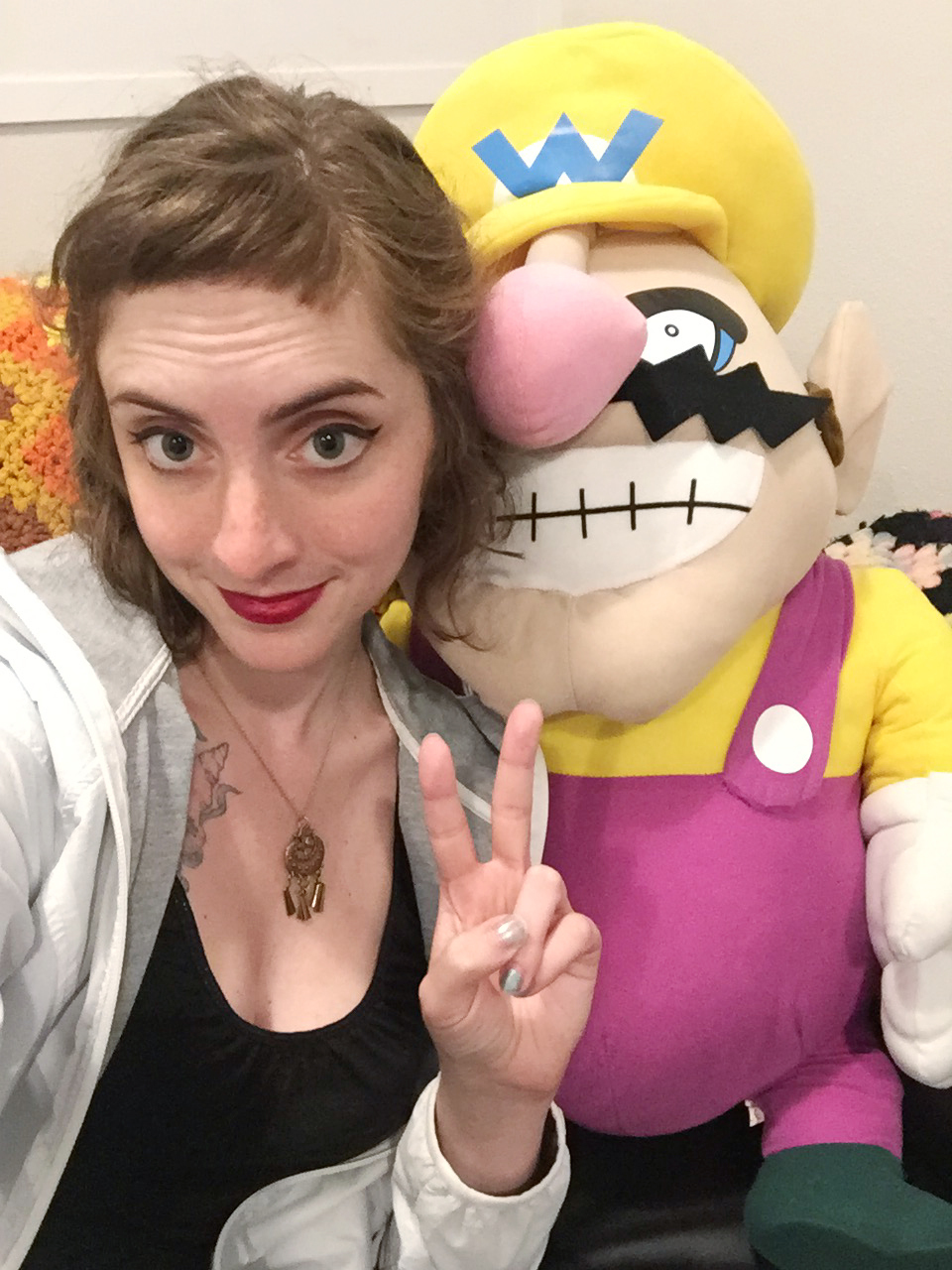
Nina Freeman is a game designer at Fullbright in Portland, Oregon. She’s best known for games like Cibele and “how do you Do It?”. This year, she released two small games: a local-multiplayer soccer game called Grass Stains, and a game about romance and sand called Beach Date. You can find her work at ninasays.so, and you can follow her on Twitter at @hentaiphd.
Before I get into my list of the best games I played this year, I wanted to reflect a bit on how I felt about games in general in 2018. It’s easy to come up with a lot of games I enjoyed, but I think it’s also important to think about how games affected me as a person. Games change me a little bit year by year, and I think it’s important to give that some thought as well.
This year, I wish I could go back in time and have a chat with my 14-year-old self about video games. I’d tell myself to look forward to all the friends I’d make through games--not just as a teen, but even up through now, in my late 20s. It’s amazing to think that some of my most meaningful relationships have happened around or in video games--from my MMO friends I met in FFXI as a tween, to my closest friends I’ve met in game development, through streaming, while playing Overwatch… it’s amazing. Games have brought the best people into my life, ever since I was a kid. 2018 was no exception--when I think about my experience with games this year, I think of all the people I spent time playing games with, and who I spent time making games with. I honestly don’t think I would have made it through the year in one piece without all of you. <3
Of course, none of this would have happened if I wasn’t playing some stuff! Onto my list of my favorite games from this year, in no particular order:
Infernium
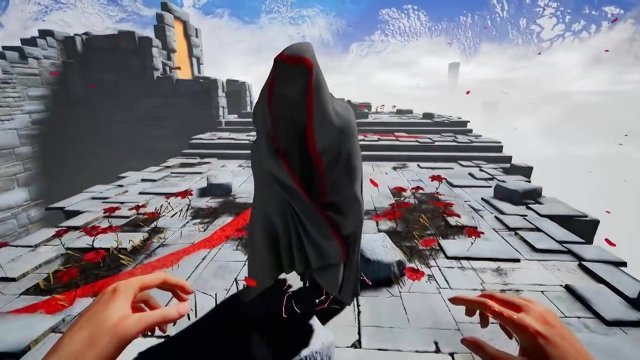
I was always too scared and intimidated by survival horror games to get into them when I was young. Then, as an adult, I got roped into playing Silent Hill 2… and to my surprise, I loved it. It’s actually probably in my top 10 favorite games ever. I’ve been a survival horror fan ever since, and this year the piece of that genre that really hit the spot for me is Infernium.
Infernium bills itself as “a survival horror approach to Pac-Man.” Pac-Man!? I know, lol, I’ll explain. Basically, it’s a first-person exploration game set in a world that breathes Dark Souls vibes. As you explore, you come across these eerie cloaked figures that follow you if you get too close to them. This is where the horrifying part and the Pac-Man part kick in. The figure follows you at a steady pace, and you basically have to figure out the optimal path through the level to outsmart/outrun it. At that point, it either de-aggros, or you find an elevator or door to go through and it simply can’t follow you anymore. It sounds simple, but it’s so damn effective and also horrifying. The chase system is complemented beautifully by some very weird and interesting level design, tense and deliberately minimal sound design, and beautifully stark environments. The upside-down castle, the invisible chained dog, the upsettingly narrow windows… it’s all so good. To my surprise, Infernium gave me similar feelings of awe and excitement that I felt when first playing Demon’s Souls, or even Myst. The game is so well-considered from every angle. It’s a game I have no hesitation in recommending to anyone.
A note about the next two games:
I was lucky enough to help run two game jams this year, alongside my good friend Josh Squires. These jams were organized for the Discord community I’ve built around my Twitch stream. Not only is this community incredibly important to me, but I was so excited to see how many of them have brilliant ideas for games. Every single game was different and special to me. For this list, I want to include my favorite from each jam (it was SO hard to pick).
Be Drunk
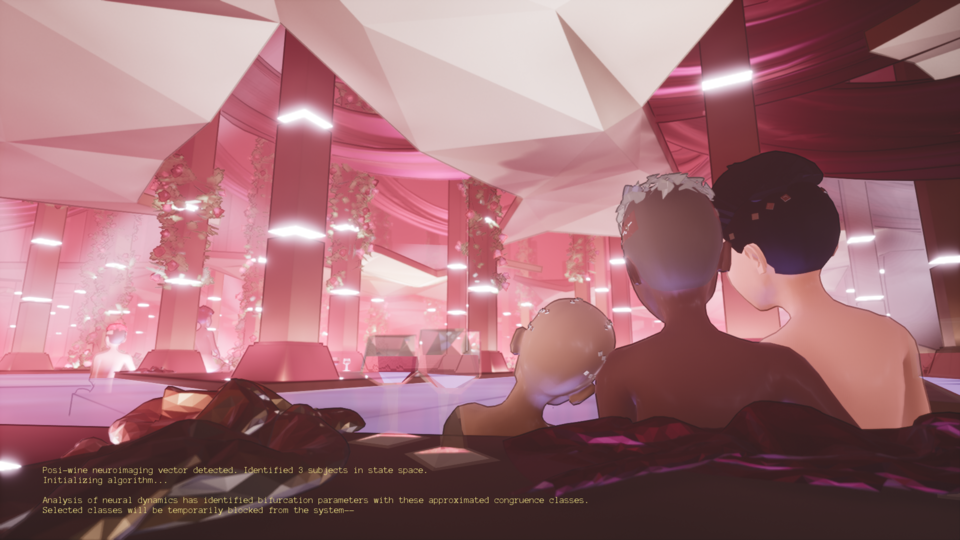
Made for: Wine Jam
Be Drunk is a game by Ash Dague about three people hanging out in a hot spring, enjoying each other's company, and having their bad thoughts managed and erased by an AI. It’s a truly contemplative game, and you simply play it until you feel done.
You play as the AI, monitoring thoughts that appear on your screen as little snippets. You can remove any thought you deem unnecessary, or maybe you choose to remove none at all. Depending on how you choose to manage thoughts, your subject becomes more or less depressed. The emotional state is communicated by your AI terminal, the saturation of color on the screen, and by the stature of the characters. So, if your subject is becoming more and more overwhelmed by negative thoughts, then they start to physically slump, and the screen becomes increasingly grey.
It’s really engrossing to play with the system, testing how the characters react to different kinds of inputs. You may consider which exact thoughts you want to remove, you can try pacing yourself in different ways, you can see what happens when you choose to do nothing… it supports a surprising amount of expressiveness. Be Drunk really makes you consider the meaning and outcome of your choices, and more generally, how our relationship to computers can change how we feel in small ways that ripple outwards until the effects are actually really noticeable. As a lifelong user of the internet, where my emotions are constantly being toyed with… this game felt really relevant to me. I super enjoyed my time with it.
Meteor-Strike!
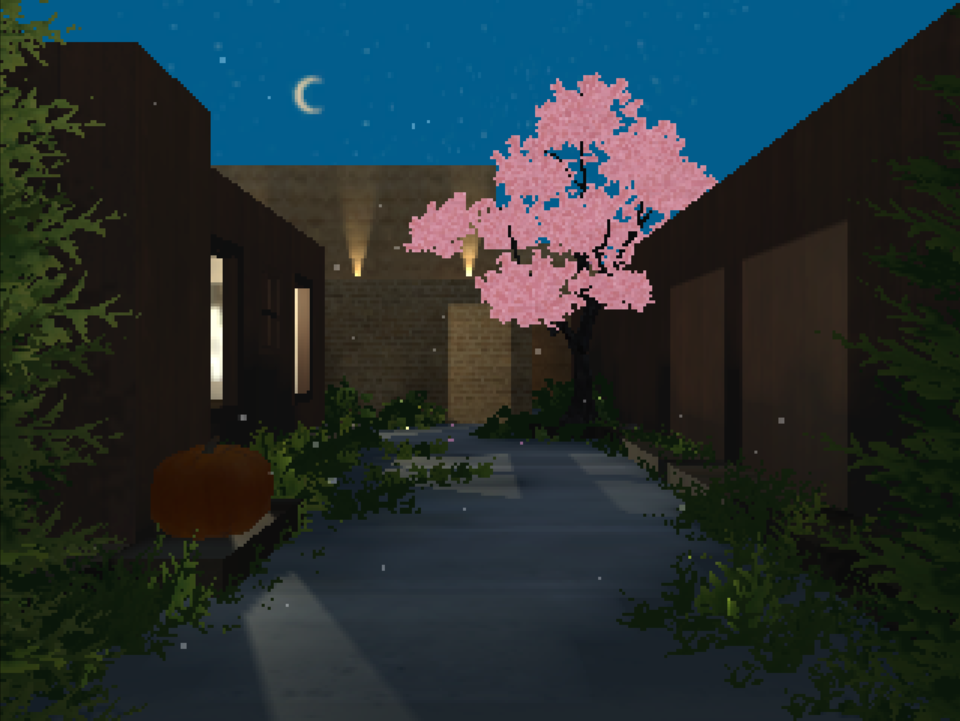
Made for: Sunset Jam
Meteor-Strike! is a game made by Toby Do. It’s a first-person game, where you walk through the mind of an e-sports player. It makes for an intimate portrait, presenting itself as the players recurring dream that starts in front of their house. The game starts you from this personal space, and gradually moves into the more public-facing aspect of the e-sports players life on the stage/screen.
You walk forwards through the dream, each space having an element of realism that is broken down by some stunning surreal moments and images. For example, when I entered the house it seemed ordinary at first… but as I walked towards the living room, I was surprised to realize that the Vietnamese food in front of me was slowly starting to float. It was a magical moment. I don’t want to spoil too much, because the moments of surprise that this game contains are just so good. Structurally, the game really reminded me of work by Davey Wreden and Brendon Chung, with its use of voice over, cinematic cuts, and the way it plays with your expectations of the game-world rules.
Life is Strange 2: Episode 1
Life is Strange 2 really took my by surprise. Naturally, I expected more heartwarming teen scenarios and a healthy dose of angst, which this game certainly gave me. However, it offers so much more. The portrait of police brutality and racism is carefully done. The way these events materially and emotionally effect the Latinx brothers that the story follows is really impactful. As we are currently living through Trump hell, the story feels especially frightening and real.
However, it’s not just about these traumatic experiences… Daniel and Sean’s human side is explored carefully as well, which I think is super important in character-driven pieces that tell political stories. Daniel and Sean don’t exist solely to explore the trauma they experience at the hands of racist bigots--they also have their brotherhood, their hobbies, their desire to have fun and enjoy life. I was struck by the scene where you’re playing as Daniel, dancing around on the bed with Sean, just having fun. It’s a purely joyful moment, without asking you to worry about anything else. The scene lets you exit whenever you want, and goes on for the whole song. I think it’s a brilliant example of game storytelling, letting the player live in the moment with these boys. The game asks you to experience both happiness and pain with them, and everything in-between. It’s a really beautiful, nuanced piece, and I’m so excited to see where the next episode takes us.
Kaiju Super Datetech
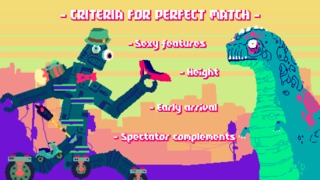
My favorite local-multiplayer game this year has to be Kaiju Super Datetech. This game was made for the 2018 Fantastic Arcade Bundle. I got to see it played live at the festival itself, which was great because it’s truly a hilarious game to watch people play.
Basically, each team is attempting to woo a massive monster that has appeared in their city. In order to capture this monster's heart, your team is racing to build the most appealing large robot. At the end of the game, the monster basically decides if it’d like to date your creation. Each player on a given team contributes to the creation of their massive robot, building and tuning the thing as it moves closer and closer to the monster. You need to attach practical parts--you know, wheels and stuff… but you can also add sexy lips or sunglasses, among other things. It’s a super funny and smart collaborative building game with a romantic, adorable twist. I think it’s a perfect game for parties, so please do check it out and play it with your friends. Local multiplayer games like this are so, so great and I’m always excited to see ones that embrace the ability to have lots of players. At the tournament, each team was made up of four people. I really recommend trying to play it with that large of a group if you can!
Side note: I also contributed to the bundle, and made a local-multiplayer soccer game called Grass Stains with my friends Diego, Aaron and Amos. Please check it out if you pick up the bundle!
All Our Asias
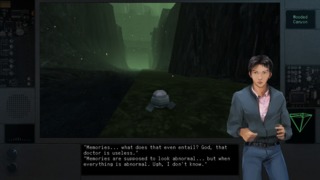
All Our Asias is a game about a young man exploring his father’s memories. The game uses this surreal environment and context to touch on some very human themes. By exploring his dying father's memories, the player-character learns about himself, his father, his race, his masculinity… it touches on all of these things through both specific life experiences and philosophical conversations encountered in the PSX-style dreamscape.
I really enjoyed how deftly the game manages to touch on all these different topics with care, whether it’s through conversations in Japanese in the train station, or the love-life vignettes in an abstract nightclub. Not only is the writing strong, but the PSX-style art in All Our Asias really floored me. It’s executed better than any game I’ve played before that tries to evoke the visual aesthetics of that era. It also uses the elegant simplicity of that style to support the game's narrative themes and tones. The memories you encounter are fragmented, and leave room for the player to read between the lines. Similarly, the environments evoke feelings and suggest imagery, the way you might remember a dream or a memory just on the tip of your tongue. I really loved playing All Our Asias, and came away from it full of inspiration. Each part of the game feels carefully crafted and considered, and it left me thinking for days.
Black Room
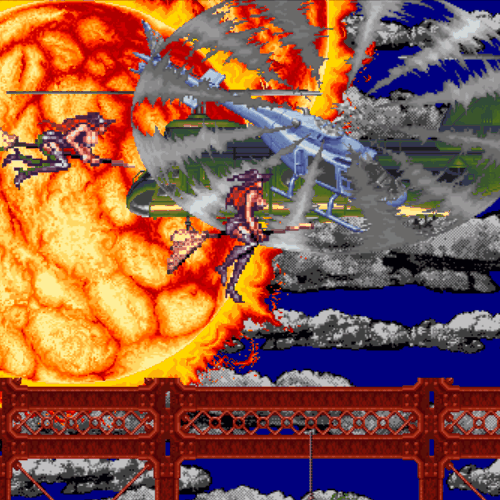
Black Room is a game about a young woman who is falling asleep at her computer. You play as her, exploring her semi-asleep consciousness, as she uses a meditation technique she learned from her mother. This setting serves as the backdrop to an exploratory browser-game with images and mechanics that will surely surprise you and leave you thinking.
I note the browser aspect of the game specifically because I think that what the game does with the browser itself is really unique and special to that space. The designer was clearly very thoughtful and thorough in coming up with ways to take advantage of all the different behaviors of a web browser. I had numerous magical moments of discovery in this game, specifically when it has you interact with the browser window (like resizing it, for example) in order to progress or find images, text and even video. I don't want to list everything mechanical that I enjoyed here, because the discovery feels so good... I really think folks should try this. I actually hope that it inspires more designers who grew up on the internet to think about browser-based games, and how the browser itself serves as an interactive canvas. I think there’s some great potential there, and Black Room taps into it in some really amazing ways.
Opus Magnum
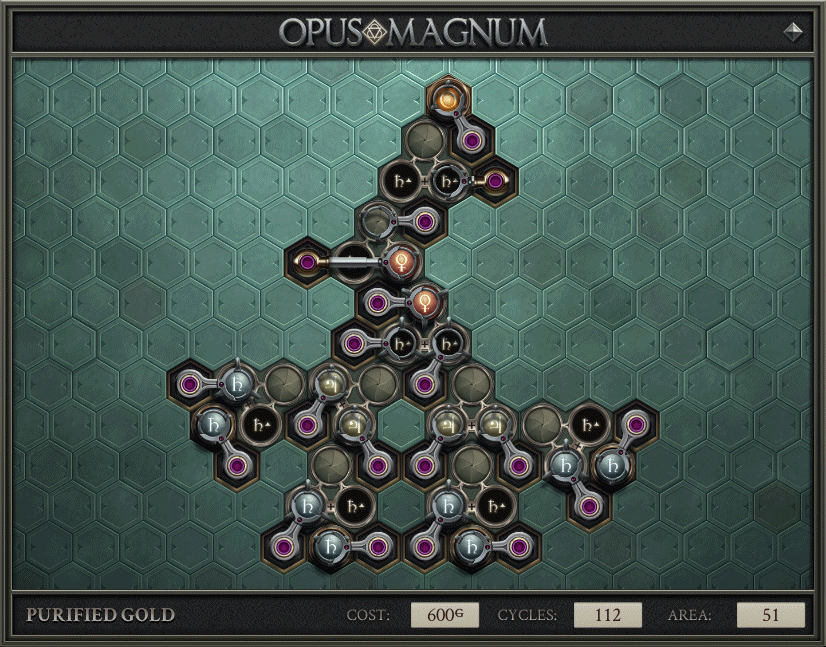
Opus Magnum is a game that I know I’m going to return to for years. It’s a brilliant puzzle game set in a world of alchemists. You play as an alchemist, creating various bits and bobs for a bunch of rich people that you work for. That’s a big oversimplification, but I do think the game does a good job of finding the humor in the alchemist's job. I just recently did a chapter where you basically make viagra for your boss’ son… and I got a good laugh out of it. The game’s narrative and writing are really strong, and have a nice balance of seriousness with humor that I super appreciate.
Mechanically and design-wise, the game really is stunning. I, personally, am not normally into puzzle games at all. I usually won’t even give them a chance, because my frustration threshold is so low, haha. However, Opus Magnum’s tutorial and introductory levels are so well paced that even I, a puzzle failure, managed to pick up and run with all the sophisticated mechanics without getting completely frustrated. Every solution, which manifests itself as a satisfying little self-running machine, feels like a work of art. It’s the kind of game where the players expression is physically manifested, and the system is complex enough that probably no two players solutions are ever the same. This kind of artistic approach to puzzle solving suits my sensibilities perfectly, and it just keeps making me want to play and build more.
Side note: The game gave me some slightly nostalgic feelings, as it prompted me to think back on some of the builder-style puzzle games I played as a kid when edutainment games were huge. If you played any games like that, you’re sure to get a warm and fuzzy feeling from Opus Magnum.
Nour

Nour is a game where you play with your food. I have played my fair share of cooking themed games, and games that have food in them, but none of them are quite like Nour. Rather than focusing on cooking or some other food-related activity, it’s about the physicality and texture of the food itself. It’s a super unique and visceral approach to food in a game.
The food exists in the game solely to be played with. You play around with the food in the scene until you feel satisfied. It almost reminds me of the fun I used to have playing with something like marbles, when I wasn’t worried about following the rules to any particular marbles game. It’s all about messing around, and seeing how each piece reacts and changes. Each button has a different effect on the food in a scene. So, for example, one button might pour boba into your cup, while another might shake the cup around. Each scene is a small diorama, lush with possibilities involving the ingredients you see on screen, and sometimes bits that appear through interaction. The game is so satisfying to play… I’ve never had so much fun with eggs in a game in my whole life. The game isn’t out yet--I played it while it was being shown at XOXO in Portland, OR. However, there is a Kickstarter going to support it, if you’re interested in giving it a go when it comes out!
Llama Villa
Llama Villa is literally The Sims, but with llamas. You start with a llama, a little patch of land, a bit of money and some fencing. From there, you’re able spend your little bit of starting cash to give the llama their essentials--a little nest to sleep in, a little sprinkler to tinkle in, a box to play with, etc. Then, hilariously, once your llama has enough of a coat, you can have them shear it and earn a little more cash to help build out their sweet little llama abode!
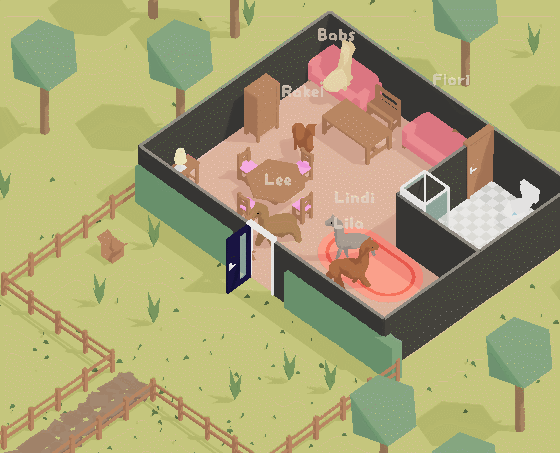
This game is made of everything good--it’s small, silly, and heartwarming in an odd way. Once your llama shears a few coats, you can even get another llama to live in the house… two llamas! I eventually had three living together, and it was honestly the most adorable thing. It’s really fun to arrange the house for these llamas, giving them gaming laptops, flat screen TVs, coffee makers and showers. You can even give them a big pink bed that they’ll rest on to get some shut eye. The game really lets you build a house that, honestly, I would live in as a human, haha. It has a surprising number of things you can use to fill and build your house. Even walls, floors, trees… the inside and outside can really be as sophisticated as you want. It’d be easy to assume that this game only stands on the gimmick of being The Sims but with llamas… but it actually has a lot to play around with, and totally stands on its own. It made me think that there’s a lot of potential for little home sims like this, that don’t totally adhere to the traditional Sims formula. It’s a refreshing game, and I hope it inspires more small games of this sort.
I want to give an extra shoutout to the whole Sokpop catalogue, which you can check out on Itch. I met this group of developers while at the Netherlands Film Festival, and they’re a really sweet crew. I also decided that they’re my favorite boy band in video games (watch their Patreon videos and you will understand lol). Their passion for small games is really inspiring to me, and Llama Villa is just one of many brilliant games they’ve made. I wanted to give their group this little extra note, because they’re probably my favorite game developers that I discovered this year! Definitely keep an eye on them--I’m sure they’re going to continue to do great things!